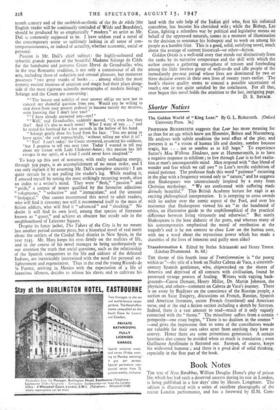Fiction
THE first venture of a highly successful painter into the field of creative writing is bound to arouse a great deal of interest. What view of life, one wonders in the case of Mr. Dali, lies behind those singular and melancholy landscapes littered with unrelated mineral, vegetable and visceral objects and protuberances, and exhibiting every sign of the deliberate cultivation of hysteria? Hidden Faces answers such questions uncontrovertibly. Mr. Dali is a romantic aesthete of the most unblushing and irrepressible kind. His high- flown, sultry and melodramatic novel is a typical manifestation of the literary current which was dealt with so exhaustively some years ago by Professor Praz in The. Romantic Agony. It is strange that such a work, so reminiscent of the Gothic school of the early nine-
teenth century and of the snobbish-aesthetic of the fin de siècle (the English reader will be continually reminded of Wilde and Beardsley), should be produced by so emphatically " modern " an artist as Mr. Dali is commonly supposed to be. I have seldom read a novel of the contemporary scene so sublimely lacking in all sense of con- temporaneousness, or indeed of actuality, whether economic, social or personal. Passion is Mr. Dali's chief subject : the highly-coloured and sybaritic grande passion of the beautiful Madame Solange de Clecla for the handsome and perverse Count Herve de Grandsailles who, in the true Romantic tradition, is not only a connoisseur of all the arts, including those of seduction and sensual pleasure, but moreover possesses " two great trunks of books . . . among which the most esoteric ancient treatises of satanism and magic had their place along- side of the most rigorous scientific monographs of modern biology." Solange and the Count are conversing :
" The beauty and nobility of your answer oblige me now not to conceal my shameful question from you. Would you be willing to step down from your present pedestal to become merely my mistress, even knowing that I don't love you? ' " I have already answered you—yes! ' "' Well,' said Grandsailles, suddenly moved, ' it's even less than that! And it's also so much more! What I want of you . . .' and he rested his forehead for a few seconds in the hollow of his hand.
" Solange gently drew his hand from his face. You are going to leave again,' she said reproachfully, without telling me what it is! ' " Yes ! I can't today,' the Count answered, resuming his coldness, ' but I promise to tell you next time. Today I wanted to tell you about my liaison with Lady Chidester-Ames ; this passion has left ravages in my spirit, of a kind I could never have imagined.' " To keep up this sort of nonsense, with really unflagging energy, through 359 pages, is an accomplishment of no mean order, and I can only explain it by assuming Mr. Dali's complete sincerity : I am quite certain he is not pulling the reader's leg. While reading it, I amused myself by noting the most strikingly recurring words, often an index to a writer's mind. They were " flesh," " passion " and " pride," a corpus of nouns qualified by the favourite adjectives " voluptuous," " seductive " and " immaculate," and the unusual " biological." One cannot recommend this novel to adult readers, who will find it tiresome; nor will it recommend itself to the mass of fiction addicts, who will find it " advanced " and " shocking." No doubt it will find its own level, among that species of literature known as " queer," and achieve an obscure but steady sale in the neighbourhood of Leicester Square.
Despite its fancy jacket, The Takers of the City is by no means just another period costume piece, but a historical novel of real merit about the settlers of the Ciudad Real district in New Spain, in the year 1545. Mr. Hays keeps his eyes firmly on the realities of life, and in the course of his novel manages to bring unobtrusively to our attention the truth that social questions, such as the relationship of the Spanish conquerors to the life and culture of the defeated Indians, are inextricably intertwined with the need for personal en- lightenment and regeneration. Thus in the end the young Ricardo de la Fuente, arriving in Mexico with the expectation of a life of luxurious idleness, decides to release his slaves and to cultivate his
land with the sole help of the Indian girl who, first /3-13- enforced concubine, has become his cherished wife ; while the Bishop, Las - Casas, fighting a relentless war by political and legislative means on behalf of the oppressed naturals,-comes hi a moment of illumination to the decision to renounce his bishopric and to work on among his people as a humble friar. This is a good, solid, satisfying novel, much above the average of current historical—or other—fiction.
Golden Oriole is a well-told story that stands out distinctively from the ranks by its narrative competence and the skill with which the author creates a gathering atmosphere of tension and foreboding among the little loveless group of well-to-do and idle people of the immediately pre-war period whose lives are- dominated by two or three decisive events in their own lives of twenty years earlier. The book's elusive quality seems to conceal a possible uncertainty of touch S one is• not quite satisfied by the conclusion. For all that, once begun this novel holds the attention to the last, intriguing page. D. S. SAVAGE.



































 Previous page
Previous page